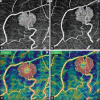Optical coherence tomography angiography in assessment of response to therapy in retinal capillary hemangioblastoma and diffuse choroidal hemangioma
- PMID: 31007251
- PMCID: PMC6498907
- DOI: 10.4103/ijo.IJO_1429_18
Optical coherence tomography angiography in assessment of response to therapy in retinal capillary hemangioblastoma and diffuse choroidal hemangioma
Abstract
In this series, we discuss the role of optical coherence tomography angiography (OCTA) in assessing response to treatment in intraocular vascular tumors. This is a series of two cases: Multiple retinal capillary hemangioblastoma (RCH) treated with laser photocoagulation and diffuse choroidal hemangioma (DCH) with radiotherapy. In large RCH and DCH, optical coherence tomography (OCT) showed significant reduction of subretinal and intraretinal fluid. But post-treatment mean tumor vascular density (MTVD) was slightly reduced. In one small RCH, vascular loop was seen suggesting minimal residual disease. So, OCTA helps in identifying treatment inadequacy and understanding alternate mechanism involved in treatment response in vascular tumors.
Keywords: Choroidal hemangioma; laser photocoagulation; optical coherence tomography angiography; retinal capillary hemangioblastoma.
Conflict of interest statement
None
Figures






Similar articles
-
Role of optical coherence tomography angiography in retinal tumors: A narrative review.Indian J Ophthalmol. 2024 Aug 1;72(8):1082-1090. doi: 10.4103/IJO.IJO_29_24. Epub 2024 Jul 29. Indian J Ophthalmol. 2024. PMID: 39078951 Free PMC article. Review.
-
CLINICALLY INVISIBLE RETINAL HEMANGIOBLASTOMAS DETECTED BY SPECTRAL DOMAIN OPTICAL COHERENCE TOMOGRAPHY AND FLUORESCEIN ANGIOGRAPHY IN TWINS.Retin Cases Brief Rep. 2018 Winter;12(1):12-16. doi: 10.1097/ICB.0000000000000382. Retin Cases Brief Rep. 2018. PMID: 27533642
-
Swept source optical coherence tomography-angiography of choroid in choroidal hemangioma before and after laser photocoagulation.Indian J Ophthalmol. 2017 Aug;65(8):751-754. doi: 10.4103/ijo.IJO_974_16. Indian J Ophthalmol. 2017. PMID: 28820167 Free PMC article.
-
Comparison of optical coherence tomography angiography and fundus fluorescein angiography features of retinal capillary hemangioblastoma.Indian J Ophthalmol. 2018 Jun;66(6):872-876. doi: 10.4103/ijo.IJO_1199_17. Indian J Ophthalmol. 2018. PMID: 29786009 Free PMC article.
-
Imaging of retinal and choroidal vascular tumours.Eye (Lond). 2013 Feb;27(2):208-16. doi: 10.1038/eye.2012.251. Epub 2012 Nov 30. Eye (Lond). 2013. PMID: 23196648 Free PMC article. Review.
Cited by
-
Role of optical coherence tomography angiography in retinal tumors: A narrative review.Indian J Ophthalmol. 2024 Aug 1;72(8):1082-1090. doi: 10.4103/IJO.IJO_29_24. Epub 2024 Jul 29. Indian J Ophthalmol. 2024. PMID: 39078951 Free PMC article. Review.
-
Detection of retinal microvascular changes in von Hippel-Lindau disease using optical coherence tomography angiography.PLoS One. 2020 Feb 20;15(2):e0229213. doi: 10.1371/journal.pone.0229213. eCollection 2020. PLoS One. 2020. PMID: 32078656 Free PMC article.
-
Comparison of Current Optical Coherence Tomography Angiography Methods in Imaging Retinal Hemangioblastomas.Transl Vis Sci Technol. 2020 Jul 8;9(8):12. doi: 10.1167/tvst.9.8.12. eCollection 2020 Jul. Transl Vis Sci Technol. 2020. PMID: 32855859 Free PMC article.
-
Optical Coherence Tomography Angiography of Early Stage 1a Retinal Hemangioblastoma in Von-Hippel-Lindau.J Kidney Cancer VHL. 2021 Sep 23;8(3):15-18. doi: 10.15586/jkcvhl.v8i3.158. eCollection 2021. J Kidney Cancer VHL. 2021. PMID: 34631390 Free PMC article.
-
Ruthenium-106 plaque brachytherapy for the treatment of diffuse choroidal hemangioma in Sturge-Weber syndrome.Int J Ophthalmol. 2020 Mar 18;13(3):513-517. doi: 10.18240/ijo.2020.03.22. eCollection 2020. Int J Ophthalmol. 2020. PMID: 32309192 Free PMC article.
References
-
- Green WR. Retina: Capillary hemangioma. In: Spencer WH, editor. Ophthalmic Pathology: An Atlas and Textbook. Philadelphia: WB Saunders; 1996. pp. 709–18.
Publication types
MeSH terms
LinkOut - more resources
Full Text Sources
Medical

